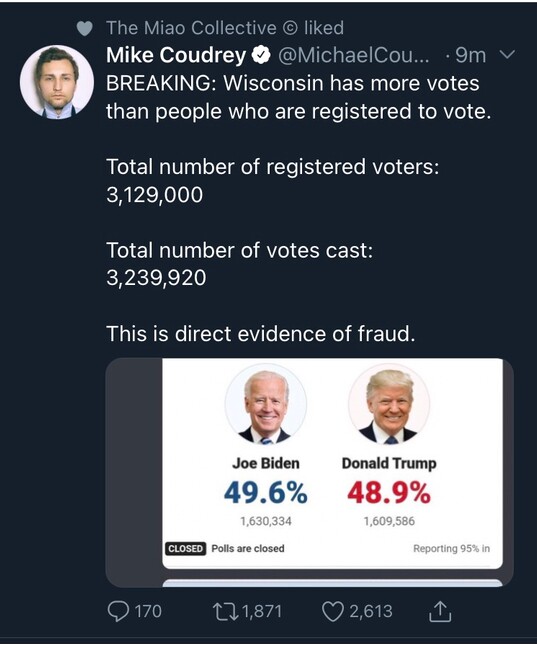Falsehoods flew in all directions on Nov. 4 as the results of the presidential election hung on a razor’s edge. After former Vice President Joe Biden took an early morning lead over President Donald Trump, speculation about Wisconsin’s vote-counting process ran wild on social media.
Just before 10 a.m., Michael Coudrey — a conservative commentator and self-described entrepreneur who “has made significant contributions to the digital media efforts in United States politics” — incorrectly claimed on Twitter to have “direct evidence of fraud.”
“Wisconsin has more votes than people who are registered to vote,” he said. “Total number of registered voters: 3,129,000. Total number of votes cast: 3,239,920.”

But that isn’t true. The state had about 3.68 million registered voters as of Nov. 1, according to the Wisconsin Elections Commission.
“That voter registration number is either old or made up,” said Reid Magney, a spokesman for the commission. “This appears to be intentional disinformation.”
It wasn’t a novel premise, either. Similarly, false information circulated ahead of the Iowa Caucus in February. Although the Wisconsin claim was presented without supporting evidence, the claim was retweeted more than 16,000 times in less than 45 minutes, immediately jumping platforms and appearing in Facebook groups such as Wisconsinites Against Excessive Quarantine.
“Once a lie leaves the barn, it’s really hard to get it back in,” said Aimee Reinhart, director of development at First Draft, a non-partisan organization that fights misinformation. “It’s almost impossible.”
The simplicity of the message — “more votes than voters” — creates a readily shareable talking point that plays into false narratives of widespread vote fraud that Trump has amplified for months. (In a Nov. 4 post that Twitter censored, Trump baselessly said that “a large number of secretly dumped ballots” had been reported, and he prematurely claimed victories in Georgia, Michigan, North Carolina and Pennsylvania.)
But that doesn’t mean the misleading claim is logically sound, said Michael Wagner, a University of Wisconsin-Madison journalism professor who studies political communication.
“What we’d have to believe is that the conspirators are so dumb, that they produced a vote total higher than the number of registered voters that anybody could find, figure out and then put a stop to,” he said. “That doesn’t make any sense.”
In an email to Wisconsin Watch, Coudrey acknowledged that he cited outdated figures in his viral tweet. Still, he expressed skepticism about Wisconsin’s count.
False narrative on vote counting
Another widely shared claim played into the false narrative that Wisconsin’s vote-counting process can’t be trusted.
Just after 3:30 a.m., a pro-Trump Twitter account posted that “Trump just lost the lead after they dumped a trove of mail-ins from Milwaukee. 100k lead gone in an instant. Why did it take hours for this to be released? I’m not buying it.” The post was retweeted 845 times.

In other viral posts, graphs shared by conservative outlet the Gateway Pundit, which amplified accusations of vote fraud in Wisconsin and Michigan, showed a dramatic increase in Democratic votes as evidence of the “ballot dump.” Gateway Pundit also falsely claimed that Wisconsin “paused counting” ballots Tuesday night before Biden took the lead. There was no pause.
In a post sharing the graph, one Twitter user claimed, “The only thing we did on Election Day was tell them how many votes they needed on Election Night.”
Elections officials had long anticipated that Wisconsin clerks would continue counting early and absentee votes past Election Day — particularly in Milwaukee, Wagner said.
“When elections are close, anything that is bad news for one side becomes evidence that there’s a secret cabal of people trying to alter the results of the election, when that of course is not true. ... This was all completely expected, but because it helps Joe Biden, supporters of Donald Trump are crying foul when there has been no foul,” he said.
Some conspiratorial posts on social media emphasize that much of Wisconsin’s vote-counting took place overnight, after many people went to bed thinking Trump had won the state’s 10 electoral votes.
“By nature, we humans are storytellers, and we have to explain why something is happening,” Reinhart said. “In the absence of a full narrative, we are going to fill in those blanks.”
Hinting that misdeeds have taken place “under cover of darkness” is a common trope in conspiratorial rhetoric, Wagner said. But elections officials in Milwaukee said in advance that they planned to count ballots overnight, and even live-streamed the process.
“Now we have to believe that the cabal of people secretly stealing the election announced their intention to do so — and can be observed — and did it anyway,” Wagner said.
Howard Hardee is a Madison-based journalist who created a misinformation toolkit for consumers funded by the Craig Newmark Philanthropies. He is a fellow at First Draft, an organization that trains journalists to detect and report on disinformation. Wisconsin Watch (wisconsinwatch.org) collaborates with Wisconsin Public Radio, PBS Wisconsin, other news media and the University of Wisconsin-Madison School of Journalism and Mass Communication. All works created, published, posted or disseminated by Wisconsin Watch do not necessarily reflect the views or opinions of UW-Madison or any of its affiliates.

